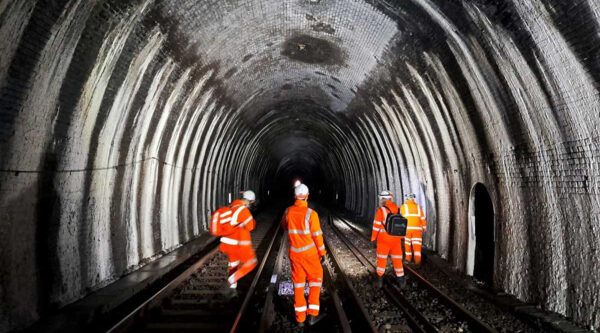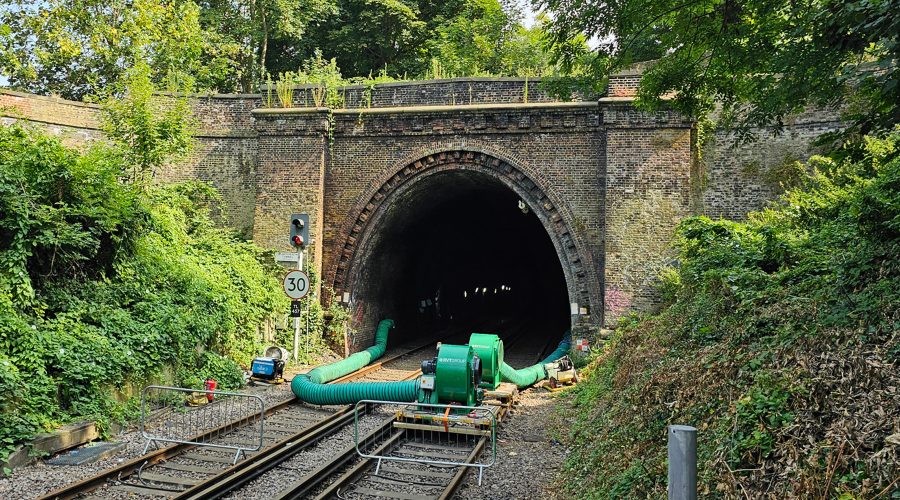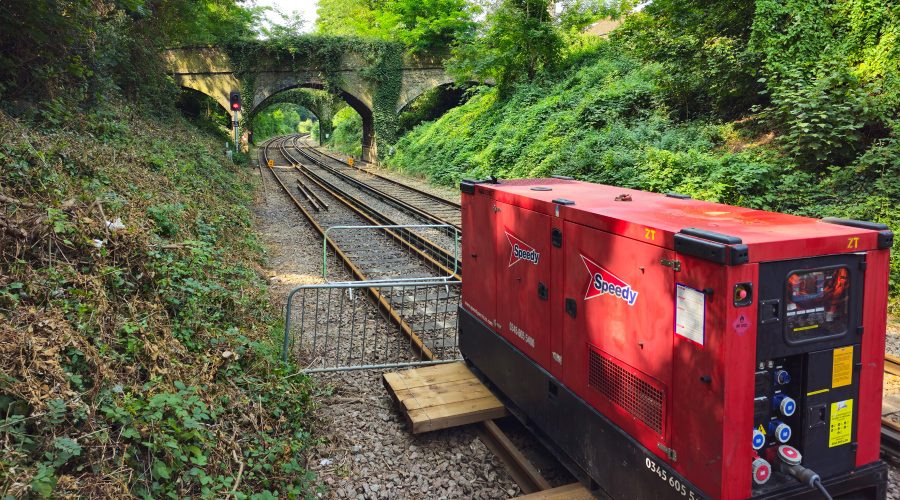[ad_1]
If you’re working half a mile inside a railway tunnel below south London, how windy it’s on the floor shouldn’t have an effect on you – however as they’ve present in Blackheath, it may.

Blackheath Tunnel (c) Community Rail
The Blackheath railway tunnel, which this 12 months marks its a hundred and seventy fifth anniversary, is at present closed for repairs because of injury from water ingress. It has confirmed to be a difficult website to work in.
However first, why is there a tunnel right here in any respect?
For those who take a look at a contemporary railway map of the realm, you’ll see two parallel railways with a spur linking them between Charlton and Blackheath, and perhaps understandably presume the spur was added to hyperlink the 2 railways.
In actual fact, the spur was as soon as the busiest a part of the railway when it opened, as the 2 parallel strains didn’t exist but.
The primary railway within the space was the London Bridge to Greenwich, which opened between 1836 and 1838.

The second railway within the space was the North Kent Line, which opened on 30 July 1849 and ran from Lewisham by way of the Blackheath Tunnel to Charlton, then to Woolwich Arsenal and on to Strood.

By 1878, the railway between London Bridge and Greenwich had been prolonged to Charlton.

In 1895, the Bexleyheath line opened, creating the 2 busy parallel railway strains, and the Blackheath tunnel began to say no in significance.

Now, 175 years after it first opened, the railway tunnel has closed for a 10-week restore and investigation programme. Repairs are wanted as a result of water leaks into the tunnel from the encircling Maze Hill, and investigations are wanted to arrange for future restore works.
They may have finished the work at weekends, however that may have taken far longer to hold out the repairs (over 100 days vs. 70 days) and would even have been significantly costlier. In actual fact, the blockade is significantly cheaper—the precise quantity is confidential, however the financial savings are very appreciable. So, a two-month blockade is much much less disruptive than two years of weekend closures and likewise saves some huge cash.
The tunnel closed on Saturday 1st June, and one of many first issues they needed to do was vacuumn the tunnel. This wasn’t simply because a clear tunnel is a pleasant tunnel, however as a result of a long time of soot and dirt obscured the brickwork, making it unimaginable to examine the tunnel for injury visually.
As defined by VolkerFitzpatrick’s agent on website, Ryan Blunt, the injury comes from the water that leaks into the tunnel, generally because of heavy rain, however primarily operating down in the direction of the tunnel from the close by hills. The geology within the space is difficult, however primarily sands and gravels, that are extra permeable to water than the heavy clays largely discovered north of the river.
Making issues worse is that the groundwater is of course barely acidic, which will increase its capacity to erode each the tunnel’s bricks and the stone ballast that helps the railway tracks. The ballast stones ought to have robust, sharp edges to grip one another and maintain the railway tracks regular, however sitting in swimming pools of barely acidic water means the ballast leads to locations trying like well-rounded pebbles, weakening their capacity to grip the railway tracks.
Ballast wants changing periodically via put on and tear, however within the Blackheath Tunnel, the impact is accelerated by the acid water impact — so fixing the leaks will imply the ballast lasts longer. That’s higher for Community Rail, which has to do much less upkeep; it additionally means much less put on and tear on the Southeastern trains rumbling over uneven tracks.
And naturally, a smoother journey for purchasers.
The opposite downside is spalling, which happens when water soaks into the brick and expands when frozen in chilly winters, blowing the bricks’ faces off. Aside from the chance of shattered brick on the railway tracks, if left unchecked, spalling may slowly begin to weaken the tunnel construction.
Thankfully, the tunnel is made up of thick layers of bricks, so VolkerFitzpatrick is ready to change the interior lining the place the bricks are struggling the worst injury. 1000’s of bricks have to be lower out of the tunnel by hand and manually changed.
It’s a quite simple however uncomfortable job. The bricks have to be eliminated, typically from the curving sides of the tunnel the place workers are working in opposition to a sloping wall, after which helps have to be added to safe the freshly uncovered brick layer behind. As soon as every row of latest bricks is added, extra helps are added to carry them in place whereas the mortar units.
All occurring deep within the almost mile-long tunnel working in a sizzling, humid surroundings.
However how does the climate have an effect on the employees within the tunnel?
Ideally, a tunnel of this size would have a air flow shaft within the center, however for some cause, the development shaft was blocked off when the tunnel opened, so sitting on the Blackheath finish of the tunnel are two enormous followers that blow recent air into it.
That retains the tunnel ventilated for the individuals working removes the modest fumes from the low-emission energy turbines used to mild the tunnel and drive the gear.

Air flow followers subsequent to the Blackheath tunnel entrance (c) ianVisits
You’d assume that air would blow into the tunnel and out the opposite aspect – however generally, the wind from the opposite aspect additionally blows into the tunnel. Meaning a bubble of stale air builds up in the course of the tunnel — the place many of the repairs are going down. If that bubble of stale air lingers lengthy sufficient, carbon monoxide builds up, alarms are sounded, and everybody leaves the tunnel till the air is obvious once more.
If that seems like a theoretical downside, as I arrived final week to go to the positioning, all the development employees had been leaving the tunnel as a result of the alarm had sounded and so they needed to anticipate the all-clear.
Clearly, there’s no downside for railway passengers as a result of there aren’t energy turbines within the tunnels, and the trains push air via the tunnels as properly.
However in the meanwhile, it’s an issue, however one they knew may very well be a difficulty when planning the restore works so was included within the timeline contingency.
The restore works are almost accomplished, however one thing else is going on which can have an effect on future repairs.
The present closure is to cope with the extra important issues, however they’ll want a pair extra closures within the subsequent few years to finish the repairs and change the observe. To find out how in depth these further repairs will have to be, they’re finishing up in depth inspections of the remainder of the tunnel and the bottom round it.
So, over the previous few weeks, they’ve drilled into the edges of the tunnel and drawn out cores of the brick and soil behind, which can then be despatched to analysts to check.
In actual fact, so many cores have been drilled into the bottom that in the event you stacked them on prime of one another, they’d be taller than The Shard skyscraper.
These cores will inform the following closures, together with whether or not stabilising the bottom behind the tunnels, perhaps with grouting, and whether or not lining the tunnel with a concrete pores and skin to guard it for the long run is important.
Meaning there may be two extra closures within the subsequent few years.

Trying in the direction of Blackheath (c) ianVisits
Within the meantime, although, the engineers and development employees are almost completed changing some 10,000 bricks within the first section of the repairs and are beginning to pack up their gear.
The tunnel is because of reopen subsequent week – on Monday twelfth August 2024.
This text was printed on ianVisits
SUPPORT THIS WEBSITE
This web site has been operating now for simply over a decade, and whereas promoting income contributes to funding the web site, however would not cowl the prices. That’s the reason I’ve arrange a facility with DonorBox the place you may contribute to the prices of the web site and time invested in writing and analysis for the information articles.
It is similar to the way in which The Guardian and lots of smaller web sites are actually searching for to generate an revenue within the face of rising prices and declining promoting.
Whether or not its a one-off donation or an everyday giver, each further assist goes an extended strategy to overlaying the operating prices of this web site, and conserving you frequently topped up doses of Londony information and info.
For those who like what your learn on right here, then please assist the web site right here.
Thanks


